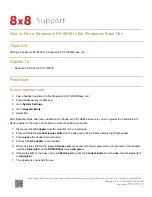
Cobham Wireless
-
Coverage
BSF0060 User Handbook
www.cobham.com/wireless
Document number: BSF0060HBK
Issue number: 5
Date: 14/05/2018
Page 8 of 43
1.6.4.
Antenna Installation
Installation of an antenna must comply with the FCC RF exposure requirements. The antenna used
for this transmitter must be mounted on permanent structures.
The FCC regulations mandate that the ERP of type B signal boosters should not exceed 5W, this is
equivalent to 8.2W EIRP.
Therefore the max antenna gain allowed for this type of signal booster should be limited to the values
given by equation 1 (below) for the service antenna.
Equation (1) - Max SERVICE antenna gain
Max SERVICE antenna gain (dBi) = 39.1 – (37dBm - # of antennas in dB – cable losses in dB).
For example:
No. of Antennas
Cable Losses
Max Allowed Antenna Gain
4
3
39.1 - (37-6-3) =11.1dBi
1
3
39.1- (37-0-3) = 5.1dbi
10
3
39.1- (37-10-3) = 15.1dbi
1.6.5.
Compliance with FCC deployment rule regarding the radiation of noise
Good engineering practice must be used in regard to the signal booster’s noise radiation. Thus, the
gain of the signal booster should be set so that the ERP of the output noise from the signal booster
should not exceed the level of -43 dBm in 10 kHz measurement bandwidth.
In the event that the noise level measured exceeds the aforementioned value, the signal booster gain
should be decreased accordingly.
In general, the ERP of noise on a spectrum more than 1 MHz outside of the pass band should not
exceed -70 dBm in a 10 kHz measurement bandwidth.
The BSF0060 Repeater has a noise level of -66 dBm in 10 kHz measurement at 1 MHz spectrum
outside the passband of the signal booster and an in-band noise level at around -46 dBm in a 10 kHz
bandwidth. Therefore, the noise at the antenna input port should be calculated based on equation
(2).
Equation (2) - Input Noise to service antenna
Input Noise to service antenna:
-66 dBm – Antenna splitter losses in dB – cable loss in dB









































